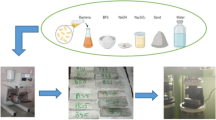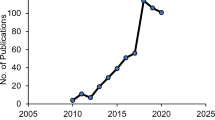Abstract
Geopolymer cement has significance in several engineering applications due to improved physical and chemical characteristics compared to ordinary portland cement (OPC). However, the emphasis on petroleum industry for cementing is not well recorded under CO2 exposure. This experimental research aims to investigate the impact of CO2-saturated brine on geopolymer-based and OPC-based cement under elevated temperature. Fly ash-based alkali-activated cement is prepared, and cement slurry is cured at two different conditions (17.23 MPa/60 °C and 24.13 MPa/130 °C). The slurry is then submerged into CO2-saturated brine using autoclave chamber at supercritical CO2 conditions for 24, 72 and 96 h. Microstructure properties are characterized using SEM, XRF, XRD, and IR. Compression strength is experimentally tested on cubical cement samples. A comparative analysis of fly ash geopolymer cement and OPC at varying conditions exhibits that microstructure and compressive strength of geopolymer cement show better performance. It signifies the potential of fly ash as a binder in sequestration cement for CO2 injection wells. This research suggests that the concentration of CO2 has a minor influence on the degree of carbonation. However, the temperature is found to be a critical factor for microstructure and mechanical properties reduction in OPC in a CO2-rich environment.








Similar content being viewed by others
Availability of data and material
The data will be available on request.
Code availability
Not applicable.
Abbreviations
- C3S (Alite):
-
Tricalcium silicate
- C2S (Belite):
-
Dicalcium silicate
- C3A:
-
Tricalcium aluminate
- C4AF:
-
Tetracalcium aluminoferrite
- GC60:
-
Geopolymer cement cured at 60 °C and 17.23 MPa
- GC130:
-
Geopolymer cement cured at 130 °C and 24.13 MPa
- PC60:
-
Class G cement cured at 60 °C and 17.23 MPa
- PC130:
-
Class G cement cured at 130 °C and 24.13 MPa
- 96GC130b:
-
Geopolymer cement after brine CO2 exposure at 130 °C and 24.13 MPa for 96 h
- 96PC130b:
-
Class G cement after brine CO2 exposure at 130 °C and 24.13 MPa for 96 h
- 72GC60b:
-
Geopolymer cement after brine CO2 exposure at 60 °C and 17.23 MPa for 72 h
- 72PC60b:
-
Class G cement after brine CO2 exposure at 60 °C and 17.23 MPa for 72 h
- 24GC130b:
-
Geopolymer cement after brine CO2 exposure at 130 °C and 24.13 MPa for 24 h
- 24PC130b:
-
Class G cement after brine CO2 exposure at 130 °C and 24.13 MPa for 24 h
References
API Recommended Practice 10A. Specification for cements and materials for well cementing; 2011.
API Recommended Practice 10B-2. Recommended practice for testing well cements; 2009.
ASTM C 109/C 109M–07 A. Standard test method for compressive strength of hydraulic cement mortars; 2008.
Bakria AMM, Kamarudin H, Hussain M, Nizar IK, Zarina Y, Rafiza AR (2011) The effect of curing temperature on physical and chemical properties of geopolymers. Phys Procedia 22:286–291
Belmokhtar N, Ammari M, Brigui J, Benallal L (2017) Comparison of the microstructure and the compressive strength of two geopolymers derived from Metakaolin and an industrial sludge. Constru Build Mater 146:621–629
Chindaprasirt P, Rattanasak U, Taebuanhuad S (2013) Resistance to acid and sulfate solutions of microwave-assisted high calcium fly ash geopolymer. Mater Struct 46:375
Davidovits J (2011) Geopolymer chemistry and applications, 3rd edn. Institute Geopolymer
Duxson P, Fernández-Jiménez A, Provis JL, Lukey GC, Palomo A, van Deventer JSJ (2007) Geopolymer technology: the current state of the art. J Mater Sci 42:2917–2933
Fauzi A, Nuruddin MF, Malkawi AB, Abdullah MMAB (2016) Study of fly ash characterization as a cementitious material. Proc Eng 148:487–493
Jacquemet N, Pironon J, Lagneau V, Saint-Marc J (2012) Armoring of well cement in H2S–CO2 saturated brine by calcite coating—Experiments and numerical modelling. Appl Geochem 27:782–795
Junaid MT, Kayali O, Khennane A (2017) Response of alkali activated low calcium fly-ash based geopolymer concrete under compressive load at elevated temperatures. Mater Struct 50:50
Kaze CR, Alomayri T, Hasan A, Tome S, Lecomte-Nana GL, Nemaleu JGD, Tchakoute HK, Kamseu E, Melo UC, Rahier H (2020) Reaction kinetics and rheological behaviour of meta-halloysite based geopolymer cured at room temperature: effect of thermal activation on physicochemical and microstructural properties. Appl Clay Sci 196:105773
Khalifeh M, Saasen A, Vralstad T, Hodne H (2014) Potential utilization of Class C fly ash-based geopolymer in oil well cementing operations. Cement Concr Compos 53:10–17
Komnitsas K, Zaharaki D (2007) Geopolymerisation: a review and prospects for the minerals industry. Mineral Engineering 20:1261–1277
Kutchko BG, Strazisar BR, Lowry GV, Dzombak DA, Thaulow N (2008) Rate of CO2 attack on hydrated Class H well cement under geologic sequestration conditions. Environ Sci Technol 42:6237–6242
Mahmoud AA, Elkatatny S, Mahmoud M. Improving Class G cement carbonation resistance using nanoclay particles for geologic carbon sequestration applications. Society of Petroleum Engineers. 2018; SPE-192901-MS.
Nuruddin MF, Demie S, Shafiq N (2011) Effect of mix composition on workability and compressive strength of self-compacting geopolymer concrete. Canadian J Civil Eng 38:1196–1203
Omosebi O, Maheshwari H, Ahmed R, Shah S, Osisanya S, Hassani S, DeBruijn G, Cornell W, Simon D (2016) Degradation of well cement in HPHT acidic environment: effects of CO2 concentration and pressure. Cement Concr Compos 74:54–70
Omosebi OA, Sharma M, Ahmed RM, Shah SN, Saasen A, Osisanya SO. Cement degradation in CO2–H2S environment under high pressure-high temperature conditions. Society of Petroleum Engineers. 2017; SPE-185932-MS.
Palomo A, Grutzeck MW, Blanco MT (1999) Alkali-activated fly ashes: a cement for the future. Cem Concr Res 29:1323–1329
Phair JW, Van Deventer JSJ (2002) Effect of the silicate activator pH on the microstructural characteristics of waste-based geopolymers. Int J Miner Process 66:121–143
Ramezanianpour AA (2014) Cement replacement materials: properties, durability, sustainability. Springer, Heidelberg
Ridha S, Irawan S, Ariwahjoedi B (2013) Strength prediction of Class G oilwell cement during early ages by electrical conductivity. J Petrol Explor Prod Technol 3:303
Ridha S, Setiawan RA, Abd Hamid AI, Shahari AR (2018) The influence of CO2 accelerated carbonation on alkali-activated fly ash cement under elevated temperature and pressure. Mater Sci Eng Technol (materialwissenschaft Und Werkstofftechnik) 49(4):483–548
Ridha S, Setiawan RA, Pramana AA, Abdurrahman M (2020) Impact of wet supercritical CO2 injection on fly ash geopolymer cement under elevated temperatures for well cement applications. J Petroleum Explorat Prod Technol 10:243–247
Ridha S, Yerikania U. New nano-geopolymer cement system improves wellbore integrity upon acidizing job: experimental findings. Society of Petroleum Engineers. 2015; SPE-176419-MS.
Ryu GS, Lee YB, Koh KT, Chung YS (2013) The mechanical properties of fly ash-based geopolymer concrete with alkaline activators. Constr Build Mater 47:409–418
Santra AK, Reddy BR, Liang F, Fitzgerald R. Reaction of CO2 with Portland cement at downhole conditions and the role of pozzolanic supplements. Soc Petrol Eng. 2009; SPE-121103-MS.
Sauki A, Irawan S (2010) Effects of pressure and temperature on well cement degradation by supercritical CO2. Int J Eng Technol 10:53–61
Velayati A, Tokhmechi B, Soltanian H, Kazemzadeh E (2015) Cement slurry optimization and assessment of additives according to a proposed plan. J Natural Gas Sci Eng 23:165–170
Zhang L, Dzombak DA, Nakles DV, Hawthorne SB, Miller DJ, Kutchko BG, Lopano CL, Strazisar BR (2013) Characterization of pozzolan-amended wellbore cement exposed to CO2 and H2S gas mixtures under geologic carbon storage conditions. Int J Greenhouse Gas Control 19:358–368
Zhang Y, Xiao R, Jiang X, Li W, Zhu X, Huang B (2020) Effect of particle size and curing temperature on mechanical and microstructural properties of waste glass-slag-based and waste glass-fly ash-based geopolymers. J Clean Prod 273:122970
Acknowledgements
The authors express their gratitude to Universiti Teknologi PETRONAS, Malaysia.
Funding
The financial assistance is provided by YUTP grant No. 015LC0-092.
Author information
Authors and Affiliations
Corresponding author
Ethics declarations
Conflict of interest
The authors declare no conflict of interest.
Additional information
Editorial responsibility: Fatih ŞEN.
Rights and permissions
About this article
Cite this article
Ridha, S., Dzulkarnain, I., Abdurrahman, M. et al. Microstructural properties and compressive strength of fly ash-based geopolymer cement immersed in CO2-saturated brine at elevated temperatures. Int. J. Environ. Sci. Technol. 19, 7589–7598 (2022). https://doi.org/10.1007/s13762-021-03665-9
Received:
Revised:
Accepted:
Published:
Issue Date:
DOI: https://doi.org/10.1007/s13762-021-03665-9




